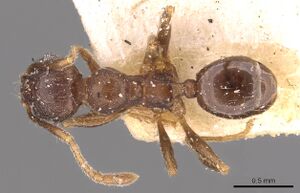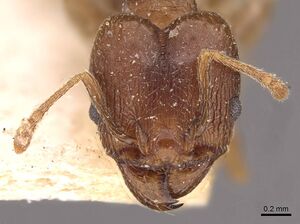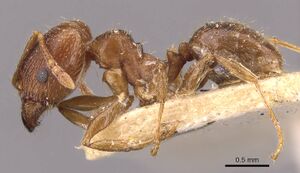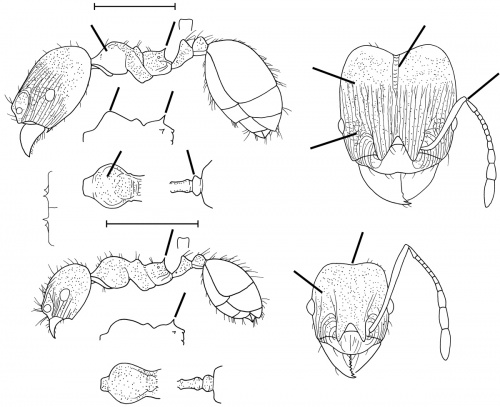Pheidole optiva
| Pheidole optiva | |
|---|---|

| |
| Scientific classification | |
| Kingdom: | Animalia |
| Phylum: | Arthropoda |
| Class: | Insecta |
| Order: | Hymenoptera |
| Family: | Formicidae |
| Subfamily: | Myrmicinae |
| Tribe: | Attini |
| Genus: | Pheidole |
| Species: | P. optiva |
| Binomial name | |
| Pheidole optiva Forel, 1901 | |
Wheeler (1901h) took the type series, which he transmitted to Forel, from large colonies nesting beneath tree-shaded stones in a ravine at Cuernavaca. Both the majors and minors were “remarkably slow” in their movements. (Wilson 2003)
Identification
See the description in the nomenclature section.
Keys including this Species
Distribution
Only known from the type locality.
Latitudinal Distribution Pattern
Latitudinal Range: 21.00859° to 18.918°.
| North Temperate |
North Subtropical |
Tropical | South Subtropical |
South Temperate |
- Source: AntMaps
Distribution based on Regional Taxon Lists
Neotropical Region: Mexico (type locality).
Distribution based on AntMaps
Distribution based on AntWeb specimens
Check data from AntWeb
Countries Occupied
| Number of countries occupied by this species based on AntWiki Regional Taxon Lists. In general, fewer countries occupied indicates a narrower range, while more countries indicates a more widespread species. |

|
Estimated Abundance
| Relative abundance based on number of AntMaps records per species (this species within the purple bar). Fewer records (to the left) indicates a less abundant/encountered species while more records (to the right) indicates more abundant/encountered species. |

|
Biology
Castes
Worker
Minor
Images from AntWeb
   
| |
| Worker. Specimen code casent0281746. Photographer Shannon Hartman, uploaded by California Academy of Sciences. | Owned by NHMUK, London, UK. |
   
| |
| Syntype of Pheidole optiva. Worker. Specimen code casent0908147. Photographer Z. Lieberman, uploaded by California Academy of Sciences. | Owned by MHNG, Geneva, Switzerland. |
Major
Images from AntWeb
   
| |
| Syntype of Pheidole optiva. Worker (major/soldier). Specimen code casent0908146. Photographer Z. Lieberman, uploaded by California Academy of Sciences. | Owned by MHNG, Geneva, Switzerland. |
Phylogeny
 Varela-Hernández & Riquelme (2024), Fig. 3. The phylogenetic status of Pheidole praehistorica among fossil and extant congeners inferred from the list of characters (Supp. file 1: Table S1) and the data matrix (Supp. file 1: Table S2), shows the twenty-eight morphological characters to construct the most parsimonious tree. The numbers above the white and black dots represent morphological characters, and the numbers below represent the character encoding. Black dots represent synapomorphies, and white dots represent homoplasies. † represents fossil species from Dominican and Mexican amber. Consistency index = 0.52; retention index = 0.65.
Varela-Hernández & Riquelme (2024), Fig. 3. The phylogenetic status of Pheidole praehistorica among fossil and extant congeners inferred from the list of characters (Supp. file 1: Table S1) and the data matrix (Supp. file 1: Table S2), shows the twenty-eight morphological characters to construct the most parsimonious tree. The numbers above the white and black dots represent morphological characters, and the numbers below represent the character encoding. Black dots represent synapomorphies, and white dots represent homoplasies. † represents fossil species from Dominican and Mexican amber. Consistency index = 0.52; retention index = 0.65.
Nomenclature
The following information is derived from Barry Bolton's Online Catalogue of the Ants of the World.
- optiva. Pheidole optiva Forel, 1901c: 132 (s.w.) MEXICO. See also: Wilson, 2003: 333.
Unless otherwise noted the text for the remainder of this section is reported from the publication that includes the original description.
Description
From Wilson (2003): A member of the fallax group, sharing some traits with Pheidole sciara but differing from it and other group members as follows.
Major: antennal scapes reaching a little less than midway between eyes and occipital corners; carinulae of dorsal head surface also reaching halfway between eye and occipital corners; dorsal head surface foveolate except for frontal triangle, mid-clypeus, and occipital border, which are smooth and shiny; pronotal dorsum and rest of mesosoma foveolate, lacking carinulae; pronotum in dorsaloblique view a single convexity peaked at humerus; propodeal spines directed posteriorly; postpetiole elliptical from above; pilosity sparse to moderate over body, and on the first gastral tergite consisting substantially of short subrecumbent hairs.
Minor: eyes medium in size, with Eye Length one-fifth Head Width; all of head, mesosoma, and waist foveolate and opaque to feebly shiny; occiput broad and concave in frontal view. MEASUREMENTS (mm) Syntype major: HW 1.12, HL 1.20, SL 0.64, EL 0.14, PW 0.60. Syntype minor: HW 0.60, HL 0.70, SL 0.68, EL 0.12, PW 0.42.
COLOR Major: body light reddish brown except for gaster, which is medium reddish brown. Minor: body medium reddish yellow except for gaster, which is dark reddish yellow.
Figure. Upper: syntype, major. Lower: syntype, minor. Scale bars = 1 mm.
Type Material
MEXICO: Cuernavaca, Morelos, col. William M. Wheeler. Musee d'Histoire Naturelle Genève and Museum of Comparative Zoology - as reported in Wilson (2003)
References
- Wilson, E. O. 2003. Pheidole in the New World: A dominant, hyperdiverse ant genus. Harvard University Press, Cambridge, MA. (page 333, fig. major, minor described)
- Forel, A. 1901d. I. Fourmis mexicaines récoltées par M. le professeur W.-M. Wheeler. II. A propos de la classification des fourmis. Ann. Soc. Entomol. Belg. 45: 123-141 (page 132, soldier, worker described)
- Varela-Hernández, F., Medel-Zosayas, B., Martínez-Luque, E.O., Jones, R.W., De la Mora, A. 2020. Biodiversity in central Mexico: Assessment of ants in a convergent region. Southwestern Entomologist 454: 673-686.
- Varela-Hernández, F., Riquelme, F. 2024. Pheidole praehistorica sp. nov., a new addition to spiny ants of the genus Pheidole Westwood, 1839 (Formicidae, Myrmicinae) from Oligo–Miocene Mexican amber. European Journal of Taxonomy 968: 86-97 (doi:10.5852/ejt.2024.968.2719).
- Wheeler, W. M. 1901c. The compound and mixed nests of American ants, Part II: The known cases of social symbiosis among American ants. Am. Nat. 35: 513–539.
References based on Global Ant Biodiversity Informatics
- Fernandes, P.R. XXXX. Los hormigas del suelo en Mexico: Diversidad, distribucion e importancia (Hymenoptera: Formicidae).
- Kempf, W.W. 1972. Catalago abreviado das formigas da regiao Neotropical (Hym. Formicidae) Studia Entomologica 15(1-4).
- Vásquez-Bolaños M. 2011. Lista de especies de hormigas (Hymenoptera: Formicidae) para México. Dugesiana 18: 95-133
- Wilson, E.O. 2003. Pheidole in the New World: A Dominant, Hyperdiverse Genus. Harvard University Press



